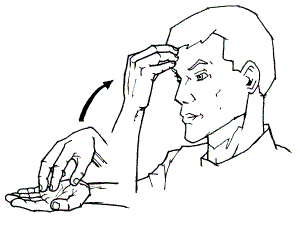Communicating with your hands
May 24th, 2020 at 11:05 pm (Language)
 … and facial expressions! A talented friend of mine started offering online lessons in American Sign Language (ASL), and so far we’ve covered basic signs (e.g., please, thank you, how do you sign…?), the manual alphabet, and how to express basic needs (e.g., hunger, thirst, sleepiness). I have dim memories of learning some ASL in high school, and it seems that the alphabet, at least, stuck with me. It’s great to learn a bunch of new vocabulary. (The image at right shows the sign for “learn”.)
… and facial expressions! A talented friend of mine started offering online lessons in American Sign Language (ASL), and so far we’ve covered basic signs (e.g., please, thank you, how do you sign…?), the manual alphabet, and how to express basic needs (e.g., hunger, thirst, sleepiness). I have dim memories of learning some ASL in high school, and it seems that the alphabet, at least, stuck with me. It’s great to learn a bunch of new vocabulary. (The image at right shows the sign for “learn”.)
I don’t know if or when I’ll get to put ASL into practice, but regardless I’m enjoying puzzling through a new kind of grammar and the… hm… performance aspect of signing. It’s not just about moving your hands; the aspects of eye contact and facial expression are also necessary, and even though it’s mostly intuitive so far, it’s new/foreign to have to think consciously about what expression goes with the sign :) I get the sense that the expressions are much more vivid and large than they are when I’m speaking English. (I’m sure it becomes natural over time.)
Some other ideas I found valuable that we’ve covered so far:
- Sign language has its own grammar, and notably it is not a literal reproduction of English with hand signs (I’ve encountered this concept before and it continues to fascinate me. It makes sense to me that what would be natural and efficient in spoken language might be quite different in signed language).
- Signs have three parts: hand shape, hand position, and motion.
- We are encouraged to fingerspell words as units, so instead of thinking/spelling “b” “o” “o” “k”, you do better to think sign-b-sign-o-sign-o-sign-k as a unit. This sounds similar to what you’d like to achieve with any foreign language: blending units into chunks to make communication more natural.
I’m looking forward to next week’s lessons!